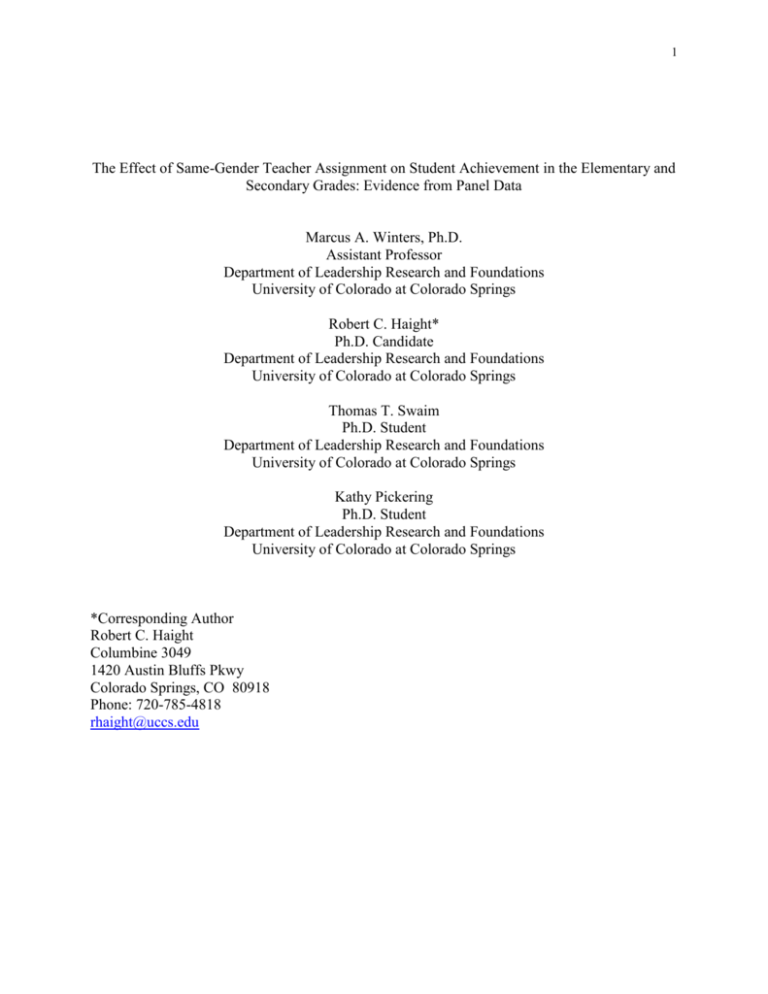Introduction - Association for Education Finance and Policy
advertisement

1 The Effect of Same-Gender Teacher Assignment on Student Achievement in the Elementary and Secondary Grades: Evidence from Panel Data Marcus A. Winters, Ph.D. Assistant Professor Department of Leadership Research and Foundations University of Colorado at Colorado Springs Robert C. Haight* Ph.D. Candidate Department of Leadership Research and Foundations University of Colorado at Colorado Springs Thomas T. Swaim Ph.D. Student Department of Leadership Research and Foundations University of Colorado at Colorado Springs Kathy Pickering Ph.D. Student Department of Leadership Research and Foundations University of Colorado at Colorado Springs *Corresponding Author Robert C. Haight Columbine 3049 1420 Austin Bluffs Pkwy Colorado Springs, CO 80918 Phone: 720-785-4818 rhaight@uccs.edu 2 Abstract We utilize information from a rich administrative panel dataset following the universe of testtaking public school students in Florida over a period of five years to estimate the relationship between same-gender teacher assignment and student achievement. We estimate how a student’s achievement changes as he/she is assigned to teachers of different genders throughout his/her academic career, holding constant both observed and unobserved factors related to academic outcomes. We also provide estimates from models that evaluate how the relative performance of male and female student assigned to the same teacher or in the same classroom relates to the gender of the teacher. We find no statistically distinguishable relationship between same-gender teacher assignments and student math or reading achievement in elementary school. We find a statistically significant relationship between being assigned to a female teacher and student achievement in middle and high school, however the magnitude of the effect is small. Keywords: educational economics, school choice 3 I) Introduction Female and male academic performance differs considerably by age and subject category. Despite students beginning kindergarten on equal footing, by the time male and female students are transitioning from middle school to high school, a clear academic disparity has developed in which female students typically outperform their male peers in subjects of reading and writing, while male students outperform female students in areas of science and mathematics (Dee, 2006; Freeman, 2004; McCrea, 2010; Robinson & Lubinski, 2011). This disparity, commonly referred to as the “gender gap”, raises concerns of equity in a national education system designed around the concept of equal access and opportunity for all students. Addressing the gender gap in student outcomes has become a significant policy concern (Novotney, 2011; Smithers & Robinson, 2006). Among the several policy levers suggested to address this gap is the use of same-sex schools and teacher assignments (see for instance, Dee 2006). Same gender teachers might serve as better role-models for students (Ammermuller & Dolton, 2006; Carrington, Tymms, & Merrel, 2008; Francis, Skelton, Carrington, Hutchings, Read, & Hall, 2006; Krieg, 2005; Nixon & Robinson, 1999). Further, assignment to a samegender teacher could influence student achievement through teacher expectations of the student’s performance (Ehrenberg et al. 1995; Carrington, Tymms, & Merrell, 2008; Nixon & Robinson 1999; Rosenthal & Jacobson, 1965). A considerable amount of research has demonstrated differences between male and female teachers in their perception and treatment of male versus female students (Krieg, 2005; McCandless, Bush & Carden, 1976; Meece, 1987; Rodriguez, 2002; Stake & Katz, 1982). However, whether such factors result in differences in the academic outcomes for male and female students when assigned to teachers of particular gender in elementary and secondary 4 school is an unsettled research question. Several studies have evaluated the effect of same-gender instructors on student outcomes in college (Bennett & Coll, 1982; Wayne & Youngs, 2003). Results from prior research evaluating the impact of assignment to a same-gender teacher in earlier grades where the gender gap develops have been mixed (Bettinger & Long 2005; Canes & Rosen 1995; Ehrenberg, Goldhaber, & Brewer 1995; Dee, 2005; Dee, 2006; Dee, 2007; Gibb, Fergusson, & Horwood, 2008; Neumark & Gardecki 1998; Nixon & Robinson 1999; Robst, Keil, & Russo 1998; Rothstein 1995). The most convincing estimates to date come from Dee (2007), which replicated panel-data procedures in the cross-sectional National Educational Longitudinal Study (NELS), by taking advantage of the fact that this study matched students with teachers in multiple subjects. The study by Dee found that assignment to a same-gender teacher significantly improves student achievement. Though mitigated in Dee’s recent paper, a limitation of the body of research looking at the effect of being assigned to a same-gender teacher is its utilization of cross-sectional data. Panel data techniques matching individual students to multiple teachers – and thus, often teachers of both genders – over time, could substantially improve upon estimation of the samegender teacher effect by better accounting for unobserved student heterogeneity. In this study we expand upon prior research by estimating the effect of teacher gender on the reading and math achievement of male and female students using a rich administrative dataset that follows the universe of test taking students enrolled in Florida public schools in grades three through ten over a period of five years. We utilize panel-data techniques to hold constant time-invariant characteristics about students and teachers. Essentially, our analysis estimates how an individual student's achievement changes as he/she is assigned to teachers of different genders throughout his/her academic career. We also considered this relationship from 5 a different angle by estimating models that evaluate how the relative performance of male and female students assigned to the same teacher or even the same classroom relates to the gender of the teacher. We found no significant relationship between teacher gender and the achievement of either male or female students in elementary grades. We do, however, find a statistically significant relationship between teacher gender and student achievement in middle and high school grades, however the effect is so mild as to be of little policy concern. In contrast to prior research, we found evidence that both female and male middle and high school students benefited when they are assigned to a female teacher, although male students appear to benefit less from having a female math teacher than their female peers. II) Data We utilized a rich dataset provided by the Florida Department of Education that contains extensive information about individual students and teachers over time, which allowed us to link them together in classrooms. The student-level dataset contains observable characteristics for the universe of test-taking Florida public school students in grades three through ten for each year from 2000-01 through 2004-05. More than 1.7 million students attached to more than 13,000 teachers in more than 3,000 schools are represented in the dataset and used in the most inclusive analyses. Along with demographic information, the dataset includes each child's scores on the math and reading portions of the state's mandated standardized exam, the Florida Comprehensive Assessment Test (FCAT). A unique student identifier allows us to track students throughout their academic careers. The data includes unique identifiers for teachers as well as an identifier for the specific 6 class (that is, a grouping of students being taught by a particular teacher in a given year) that is present in both the student and teacher datasets, thus allowing us to match students to particular teachers and classrooms. Finally, the dataset also includes an identifier for the course number of a class, so we also know the class type as well as the particular teacher for a given student, which is particularly important in the middle and high school grades when students tend to have different teachers for each academic subject. A challenge to effectively utilizing this dataset for estimation, is that students are very often assigned to more than one classroom and/or more than one teacher for a given academic subject. This is problematic because the unit of observation in the analysis must be for a single child-year observation and its pairing with single teacher-year information. When creating the dataset we assume that only one teacher is responsible for each child's academic growth in a particular subject (math or reading). It is likely the case that the child's primary teacher in an elementary class is most responsible for his/her achievement in math and reading. To arrive at a single student-year observation matched to a single teacher we develop a series of screening rules to eliminate additional observations of a student-teacher-year match where we had multiple such observations. These screens were recently imposed in a recent paper using Florida data (Winters, Dixon, & Greene). The first screens are intended to match the student to the teacher most responsible for their score in the subject under consideration. For elementary grades, we first used observations for students enrolled in a general class (i.e. a class designated as "Third Grade". We then matched students to teachers in classes aligned with the subject that was being evaluated – math or reading. In the next screen, when students continued to have more than one student-teacheryear observation, we excluded such matches where the teacher was listed as not being "full 7 time". The idea here is that most part time teachers are unlikely to be the child's primary teacher in a given classroom or subject. If, after these screens, we were still left with multiple observations of a student-teacher-year match, we randomly determined which observation to include. In middle school and high school grades we were able to match students to a single teacher with our screens before resorting to random matching for about 99 percent of students in both math and reading. For elementary grades, we were able to match about 93 percent of students to a single teacher before resorting to a random match; about 98 percent of students were assigned to fewer than two teachers prior to random assignment. III) Methodology Our procedure takes advantage of the panel nature of the dataset to examine the relationship between teacher gender and the proficiency of male and female students. We utilize multiple approaches in order to view the data from a variety of angles and to check the robustness of our results. In particular, we estimate models that utilize different levels of fixed effects--at the school, student, teacher, and classroom level. Though each of the models considers a similar relationship, the ways that they are interpreted can differ substantially. In this section we describe the general estimation strategies and how each should be interpreted. Student Models Our primary approach accounts for unobserved student heterogeneity through the use of fixed-effects at the student level. These models are concerned with estimating the effect of the teacher's gender on the student's test score in a particular year while accounting for other factors. We estimate models taking the form: (1) y ijst 0 1 X ijst 2 Z ijst 3 FemaleTeachijst t i ijst 8 Where yijst is the test score of student i, assigned to teacher j, in school s, during year t; X is a vector of observed student characteristics; Z is the years of experience of the student's teacher; FemaleTeach is an indicator that equals one if the student's teacher is female; φ is a fixed-effect for the school year; α is a student fixed-effect; and ε is a stochastic term clustered by school. The use of a student fixed-effect in (1) accounts for student heterogeneity by estimating the coefficients within, rather than across students. We also report models that remove the student fixed-effect and replace it with a fixed-effect for the student's school. When estimating models that exclude the student fixed-effect, we include time-invariant student characteristics as well as the student's test score in the prior year to account for historical schooling and unobserved student heterogeneity.1 We are interested in whether the effect of a teacher's gender differs according to student gender. Because student gender is a time-invariant characteristic, and thus cannot be estimated in a model that includes a student fixed-effect, we estimate (1) separately for male and female students. We can interpret β3 as the relationship between being taught by a female teacher rather than a male teacher and the student's test score at the end of the year. Though we account for unobserved student heterogeneity through fixed-effects or by accounting for prior student proficiency, we are not able to directly account for non-random matches of students to teachers of a particular gender. This would be a problem if, for example, female teachers are more likely to be assigned higher achieving students whose ability is not entirely captured by the controls in the model (see for example, Rothstein 2009). Thus, while informative, we do not claim our estimate of β3 as strictly causal. Since testing begins in the third grade, these models exclude third grade students. We tested whether any differences between the school and student fixed-effects models were due to this additional sample restriction by also estimating models that include a student fixed-effect but exclude third grade students. Results from student fixed-effects models were very similar whether or not third grade students were included. 1 9 Student Achievement by Gender Within Teachers and Classrooms Our second set of models looks at the data in a different way in order to evaluate the influence of teacher gender on student achievement. Where the previous models took the perspective of the student, this group of models evaluates how female students fare relative to male students assigned to the same teacher or classroom given the gender of the teacher. We again utilize student-level observations over time. Our first model employs a teacher fixed-effect which allows for the estimation of the relationship between student gender and achievement to take place within teachers. The model takes the form: (2) yijst 0 1 y ijst1 2 X ijst 3 Z ijst 4 FemaleStudent t j ijst Where FemaleStudent is an indicator that equals one if the student is female; θ is a teacher fixedeffect; μ is a stochastic term clustered by school; and all other variables are as previously defined. Note that (2) accounts for historical schooling and unobserved student heterogeneity by incorporating a control for the student's prior test score. Since testing in Florida begins in the third grade, the inclusion of prior test score forces us to exclude third grade students when estimating (2). Since the teacher's gender is a time-invariant characteristic, it cannot be estimated when including a teacher fixed-effect. Thus, we estimate (2) separately for male and female teachers. Note that this procedure differs from the prior approach--when estimating (1) we restricted the model to include students of a particular gender. Though model (2) is similar to (1) in many respects, we interpret its coefficient of interest (δ4) differently than in the prior approach. The estimate of δ4 represents the achievement of female students relative to male students when assigned to a particular teacher. Thus, a positive 10 coefficient suggests that female students gain ground relative to male students when taught by a particular teacher. We further expand upon (2) by estimating models that replace the teacher fixed-effect with a fixed-effect for individual classrooms (that is, a group of students taught in the same classroom by a particular teacher). The classroom fixed-effect differs from the teacher fixedeffect in that teachers are assigned to multiple classrooms over their career and in the case of middle school teachers, within a particular year. The classroom fixed-effect model looks at the relative achievement of male and female students within particular classes. We again separate models for male and female teachers. Formally, we estimate models taking the form: (3) y icjst 0 1 y icjst1 2 X icjst 3 Z icjst 4 FemaleStudent t c icjst Where the index c represents a particular class; π is a fixed-effect for the class; and τ is a stochastic term clustered by school. III) Results In this section, we discuss the estimation results from our several approaches individually. To ease interpretation, the test scores have been standardized by grade and year prior to estimation to have a mean of zero and a standard deviation of one. As mentioned previously, all standard errors are clustered by school. Student Models The first set of results to be discussed derives from the estimation of various forms of equation (1). These regressions are restricted to students of a particular gender and account for unobserved student heterogeneity through the use of a student fixed-effect or by accounting for the student’s test score in the previous year. The coefficient of interest in these models is an 11 indicator for whether the student’s teacher was female. We first consider the results of estimating various forms of (1) for student math test scores. Table 1 reports estimates from models that include all grade levels, as well as models restricted to include only elementary or middle/high school grades. Separate results are given for regressions restricted to female and male students. In order to evaluate the robustness of our findings, we report results from models that include either a student or school fixed effect. Further, in order to test whether any differences between models that utilize a student fixedeffect and those that account for prior test scores are due to the fact that the latter regressions exclude third grade students, we also report the results of regressions that include a student fixedeffect and exclude third grade test scores. Thus, Table 1 includes sixteen regressions in total. As shown in the table, the results from estimations that include all grade levels show a statistically significant positive relationship between having a female teacher and math achievement for both male and female students. Though a direct significance test is not possible, it appears that female students benefit from having a female teacher in math slightly more than do male students, though the size of the effect is mild for students of each gender. [TABLE 1 ABOUT HERE] The remainder of Table 1 evaluates whether the relationship between teacher gender and student achievement differs for students in elementary and middle/high school grades. We find no statistically distinguishable relationship between teacher gender and student achievement in the elementary grades. However, when we look at grades six through ten, once again the results return to being significant, demonstrating that the contribution to student achievement for female teachers occurs after the elementary grades. Thus, the effect of teacher gender on student achievement found in the overall model appears to be driven by the relationship found for older 12 students. Table 2 reports the results from similar analyses looking at the effects of teacher gender on student reading achievement. As in math, we find that female teachers contribute to reading achievement for both female and male students, though the effect for both genders is mild at best. For the elementary grades, our primary model that includes a student fixed-effect finds no significant relationship between having a female teacher and reading achievement, but the contribution to student achievement shows up in the later grade levels. [TABLE 2 ABOUT HERE] In order to map the effect across grade levels in greater detail, Tables 3 and 4 report the results of regressions restricted to students of particular grade levels. Since most students are only observed in a grade once, these regressions only use a school fixed-effect for this analysis and account for student heterogeneity by controlling for the prior year’s test score. [TABLE 3 ABOUT HERE] [TABLE 4 ABOUT HERE] As the previous regressions would suggest, the results for contribution to math achievement by grade for both female and male students are insignificant in the elementary school grades but begin to become significant in middle school. Consistent with the prior results, female teachers contribute to female student math and reading achievement at a slightly higher rate than they do for male students. Teacher and Classroom Models The second class of models we consider, estimate the effect of how female students perform compared to male students assigned to the same teacher or classroom given the gender of the teacher. These models are restricted to teachers of a particular gender, and the coefficient 13 of interest is an indicator for whether the student is female. In this case, we would interpret a negative coefficient estimate, for instance, as showing that female students lose ground relative to male students when assigned to a particular teacher or in a particular class. Table 5 reports the results for the estimation in math that includes all grade levels. Consistent with previous research on the gender gap, the results from the complete model and also for models restricted to elementary and middle/high school grades show that female students tend to lose ground to male students whether assigned to a male or female teacher. However, though significance testing is not possible, it appears from the results that female students lose slightly less ground to male students when assigned to a female teacher than when assigned to a male teacher. [TABLE 5 ABOUT HERE] The results from similar models analyzing the impact of teacher gender on student reading achievement, including a teacher fixed effect, are reported in Table 6. Consistent with descriptive data about the gender gap, the positive coefficient estimates indicate that female students tend to outperform male students in reading. As was the case in math, female students appear to benefit somewhat more from being assigned to a female teacher than do male students, though significance testing is impossible in this case. However, again the effect of being assigned to a female teacher for students of both genders is statistically significant but small in magnitude. [TABLE 6 ABOUT HERE] The last set of analyses focuses on student achievement within the classroom. Tables 7 and 8 show that the results from classroom fixed-effects models are very similar to those found for models that included a teacher fixed-effect. 14 [TABLE 7 ABOUT HERE] [TABLE 8 ABOUT HERE] IV) Conclusion Addressing the gap in performance between male and female students is a significant policy concern. One interesting policy lever that has been considered to reduce the gender achievement gap is to assign students to teachers of the same gender. Teachers of the same gender could theoretically improve a student’s achievement by serving as high-quality role models or because they are more inclined to think positively about the student’s potential. This paper adds to previous research, measuring the relationship between being assigned to a same-gender teacher and student achievement in math and reading. We improve upon prior research by taking advantage of a rich panel dataset following a large number of students over a period of five years. Thus, our model is able to estimate how the same students fare when assigned to a male or female teacher as they proceed through their academic careers. Our results are not promising for the use of same-gender teacher assignments to improve student achievement or reduce the gender gap. We find no relationship between same-gender teacher assignments and student achievement in elementary school. We do find a statistically significant relationship between being assigned to a female teacher and student achievement in middle and high school, however the magnitude of the effect is of little policy significance. 15 References Ammermuller, A., & Dolton, P. (2006). Pupil-teacher interaction effects on scholastic outcomes in England and the USA. Center for European Economic Research: Discussion Paper No. 06-060. Bennett, S. K., & Coll, B. M. (1982). Student perceptions of and expectations for male and female instructors: Evidence relating to the question of gender bias in teaching evaluation. Journal of Educational Psychology (74)2. 170-179. Carrington, B., Tymms, P., & Merrell, C. (2008). Role models, school improvement and the ‘gender gap’—Do men bring out the best in boys and women the best in girls? British Educational research Journal, (34)3, 315-327. Dee, T. S. (2005). A teacher like me: Does race, ethnicity, or gender matter? The American Economic Review, 95(2), 158-165. Dee, T. S. (2006). The why chromosome. Education Next, 6(4), 68. Dee, T. S. (2007). Teachers and the gender gaps in student achievement. Journal of Human Resources, 42(3), 528. Ehrenberg, R. G., Goldhaber, D. D., & Brewer, D. J. (1995). Do teachers' race, gender, and ethnicity matter?: Evidence from NELS88. The National Bureau of Economic Research: Working Paper No. 4669. Ferrara, M. M. (2009). The student and the teacher—Making a match in a single-gender classroom. Advances in Gender and Education, (1). 14-21. Francis, B., Skelton, C., Carrington, B., Hutchings, M., Read, B. & Hall, I. (2006). A perfect match? Pupils’ and teachers’ views of the impact of matching and learners by gender. Research Papers in Education, (23)1, 21-36. 16 Freeman, C. (2004). Trends in educational equity of girls & women: 2004. U.S. Department of Education. Institute of Education Sciences. National Center for Education Statistics. Gibb, S. J., Fergusson, D. M., & Horwood, L. J. (2008). Effects of single-sex and coeducational schooling on the gender gap in educational achievement. Australian Journal of education, (52)3. Krieg, J. M. (2005). Student gender and teacher gender: What is the impact on high stakes test scores? Current Issues in Education, (8)9. McCandles, B., Bush, C., & Carden, A. (1976). Reinforcing contingencies for sex-role behaviors in preschool children. Contemporary Educational Psychology, (1). 241-246. McCrea, B. (2010). Engaging girls in STEM. THE Journal. Meece, J. L. (1987). The influence of school experiences on the development of gender schemata. New Directions for Child and Adolescent Development, (38). 57-73. Neugebauer, M., Helbig, M., & Landmann, A. (2010). Unmasking the myth of the same-sex teacher advantage. European Sociological Review. Nixon, L. A., & Robinson, M. D. (1999). The educational attainment of young women: Role model effects of female high school faculty. Demography, (36)2, 185-194. Novotney, A. (2011). Coed versus single sex ed: Does separating boys and girls improve their education? American Psychological Association, (42)2. 58. Robinson, J. P., & Lubienski, S. T. (2011). The development of gender achievement gaps in mathematics and reading during elementary and middle school: Examining direct cognitive assessments and teacher ratings. American Educational Research Journal, (48)2, 268-302. Rodriguez, N. (2002). Gender Differences in Disciplinary Approaches. 17 Rosenthal, R.; & Jacobson, L. (1965). Pygmalion in the classroom. The Urban Review, (3)1, 1620. Smithers, A., & Robinson, P. (2006). The Paradox of Single-Sex and Co-educational Schooling. Buckingham, U.K.: Carmichael Press. Spielhofer, T., O’Donnell, L., Benton, T., Schagen, S. & Schagen, I. (2002). The Impact of School Size and Single-Sex Education on Performance. Berkshire, U.K.: National Foundation for Educational Research Stake, J. E., & Katz, J. F. (1982). Teacher-pupil relationships in the elementary school classroom: Teacher-gender and pupil-gender differences. American Educational research Journal, (19)3. 465-471. Wayne, A. J., & Youngs, P. (2003). Teacher characteristics and student achievement gains: A review. Review of Educational Research, (73)1. 89-122. Winters, M. A., Dixon, B. L. & Greene, J. P. (2012). Observed characteristics and teacher quality: Impacts of sample selection on a value added model. Economics of Education Review. 18 Table 1 - Effects of Teacher Gender on Student Math Achievement Female Students All Grades Female Teacher Elementary Grades Grades 6 - 10 0.0246*** 0.0197*** 0.0196*** 0.00415 -0.000768 0.0059 0.0281*** 0.0206*** [9.316] [8.374] [8.430] [0.712] [-0.0529] [0.485] [9.675] [7.452] Male Students All Grades Female Teacher Excludes Third Grade Prior Test Score Time Invariant Student Characteristics Time Variant Student Characteristics Year Grade Level Teacher Years of Experience School Fixed-Effect Student Fixed-Effect Elementary Grades Grades 6 - 10 0.0151*** 0.0141*** 0.0136*** -0.0011 -0.00735 -0.00606 0.0182*** 0.0125*** [5.359] [5.533] [5.440] [-0.195] [-0.556] [-0.569] [5.734] [3.641] YES YES YES NO NO NO YES YES YES NO NO NO N/A YES N/A NO YES NO NO YES NO NO YES NO YES YES YES YES YES YES YES YES YES YES YES YES YES YES YES YES YES YES YES YES YES YES YES YES YES YES YES YES YES YES YES YES YES NO NO YES NO YES YES NO NO YES NO YES YES NO NO YES Dependent variable is the student's score on the FCAT math test. Time invariant student characteristics include race/ethnicity, gender, indicators for whether the student is eligible for free or reduced priced lunch, and. Time variant student characteristics is an indicator for whether the student is identified as having limited proficiency in English. Tstatistics based on standard errors clustered by school in brackets. 19 Table 2 - Effect of Teacher Gender on Student Reading Achievement Female Students All Grades Female Teacher Elementary Grades Grades 6 - 10 0.0109*** 0.00700*** 0.00758*** 0.0145*** 0.00772 0.00987 0.00972*** 0.00950*** [4.060] [2.853] [3.128] [3.291] [0.670] [1.065] [3.012] [3.014] Male Students All Grades Female Teacher Excludes Third Grade Prior Test Score Time Invariant Student Characteristics Time Variant Student Characteristics Year Grade Level Teacher Years of Experience School Fixed-Effect Student Fixed-Effect Elementary Grades Grades 6 - 10 0.0156*** 0.00887*** 0.00939*** 0.0142*** 0.0161 0.0149 0.0157*** 0.00723* [5.738] [3.400] [3.671] [3.113] [1.352] [1.579] [4.807] [1.943] YES YES YES NO NO NO YES YES YES NO NO NO N/A YES N/A NO YES NO NO YES NO NO YES NO YES YES YES YES YES YES YES YES YES YES YES YES YES YES YES YES YES YES YES YES YES YES YES YES YES YES YES YES YES YES YES YES YES NO NO YES NO YES YES NO NO YES NO YES YES NO NO YES 20 Table 3 -- Effect of Teacher Gender on Student Math Achievement By Grade Female Students Grade 4 Grade 5 Grade 6 Grade 7 Grade 8 Grade 9 Grade 10 0.00768 0.00279 0.0280*** 0.0367*** 0.0179*** 0.0341*** 0.0224*** [0.890] [0.393] [4.066] [6.141] [2.874] [6.123] [4.340] Grade 4 Grade 5 Grade 6 Grade 7 Grade 8 Grade 9 Grade 10 0.00876 -0.0029 0.0241*** 0.0215*** 0.00759 0.0259*** 0.0119** [1.075] [-0.423] [3.153] [3.164] [1.213] [4.892] [2.242] Prior Test Score Time Invariant Student Characteristics Time Variant Student Characteristics Year Teacher Years of Experience YES YES YES YES YES YES YES YES YES YES YES YES YES YES YES YES YES YES YES YES YES YES YES YES YES YES YES YES YES YES YES YES YES YES YES School Fixed-Effect YES YES YES YES YES YES YES Female Teacher Male Students Female Teacher Dependent variable is the student's score on the FCAT math test. Time invariant student characteristics include race/ethnicity, gender, indicators for whether the student is eligible for free or reduced priced lunch, and. Time variant student characteristics is an indicator for whether the student is identified as having limited proficiency in English. T-statistics based on standard errors clustered by school in brackets. 21 Table 4 -- Effect of Teacher Gender on Student Reading Achievement By Grade Female Students Female Teacher Grade 4 Grade 5 Grade 6 Grade 7 Grade 8 Grade 9 Grade 10 0.00934 0.0115** 0.00642 0.0133** 0.0148** 0.00354 0.0161** [1.259] [2.139] [0.963] [2.116] [2.145] [0.547] [2.261] Male Students Grade 4 Grade 5 Grade 6 Grade 7 Grade 8 Grade 9 Grade 10 0.0106 0.00675 0.0133* 0.0121* 0.0187** 0.00904 0.0256*** [1.427] [1.199] [1.916] [1.840] [2.508] [1.372] [3.280] Prior Test Score Time Invariant Student Characteristics Time Variant Student Characteristics Year YES YES YES YES YES YES YES YES YES YES YES YES YES YES YES YES YES YES YES YES YES YES YES YES YES YES YES YES Teacher Years of Experience YES YES YES YES YES YES YES School Fixed-Effect YES YES YES YES YES YES YES Female Teacher Dependent variable is the student's score on the FCAT reading test. Time invariant student characteristics include race/ethnicity, gender, indicators for whether the student is eligible for free or reduced priced lunch, and. Time variant student characteristics is an indicator for whether the student is identified as having limited proficiency in English. T-statistics based on standard errors clustered by school in brackets. 22 Table 5 -- Student Math Achievement By Gender Within Teacher All Grades Female Student Elementary Grades Grades 6 - 10 -0.038*** -0.0244*** -0.0131*** -0.0151*** -0.042*** -0.029*** [-22.05] [-22.75] [-3.345] [-10.27] [-22.28] [-20.66] Teacher Gender Male Female Male Female Male Female Prior Test Score Time Invariant Student Characteristics Time Variant Student Characteristics Year Grade Level Teacher Years of Experience Teacher Fixed-Effect YES YES YES YES YES YES YES YES YES YES YES YES YES YES YES YES YES YES YES YES YES YES YES YES YES YES YES YES YES YES YES YES YES YES YES YES YES YES YES YES YES YES Dependent variable is the student's score on the FCAT math test. Time invariant student characteristics include race/ethnicity, gender, indicators for whether the student is eligible for free or reduced priced lunch, and. Time variant student characteristics is an indicator for whether the student is identified as having limited proficiency in English. Tstatistics based on standard errors clustered by school in brackets. 23 Table 6 -- Student Reading Achievement By Gender Within Teacher All Grades Elementary Grades Grades 6 - 10 0.0122*** 0.0147*** 0.0192*** 0.0224*** 0.00970*** 0.0116*** [5.771] [14.31] [5.032] [14.57] [3.880] [8.936] Teacher Gender Male Female Male Female Male Female Prior Test Score Time Invariant Student Characteristics Time Variant Student Characteristics Year Grade Level Teacher Years of Experience Teacher Fixed-Effect YES YES YES YES YES YES YES YES YES YES YES YES YES YES YES YES YES YES YES YES YES YES YES YES YES YES YES YES YES YES YES YES YES YES YES YES YES YES YES YES YES YES Female Student Dependent variable is the student's score on the FCAT reading test. Time invariant student characteristics include race/ethnicity, gender, indicators for whether the student is eligible for free or reduced priced lunch, and. Time variant student characteristics is an indicator for whether the student is identified as having limited proficiency in English. Tstatistics based on standard errors clustered by school in brackets. 24 Table 7 -- Student Math Achievement By Gender Within Classroom All Grades Female Student Elementary Grades Grades 6 - 10 -0.049*** -0.032*** -0.013*** -0.0153*** -0.0551*** -0.0407*** [-24.97] [-27.30] [-3.008] [-9.443] [-25.61] [-26.14] Teacher Gender Male Female Male Female Male Female Prior Test Score Time Invariant Student Characteristics Time Variant Student Characteristics Year Grade Level Teacher Years of Experience Classroom Fixed-Effect YES YES YES YES YES YES YES YES YES YES YES YES YES YES YES YES YES YES YES YES YES YES YES YES YES YES YES YES YES YES YES YES YES YES YES YES YES YES YES YES YES YES Dependent variable is the student's score on the FCAT math test. Time invariant student characteristics include race/ethnicity, gender, indicators for whether the student is eligible for free or reduced priced lunch, and. Time variant student characteristics is an indicator for whether the student is identified as having limited proficiency in English. T-statistics based on standard errors clustered by school in brackets. 25 Table 8 -- Student Math Achievement By Gender Within Classroom All Grades Elementary Grades Grades 6 - 10 0.00247 0.00623*** 0.0183*** 0.0214*** -0.00408 -0.00125 [1.010] [5.369] [4.296] [12.67] [-1.404] [-0.859] Teacher Gender Male Female Male Female Male Female Prior Test Score YES YES YES YES YES YES YES YES YES YES YES YES YES YES YES YES YES YES Year YES YES YES YES YES YES Grade Level YES YES YES YES YES YES Teacher Years of Experience YES YES YES YES YES YES Classroom Fixed-Effect YES YES YES YES YES YES Female Student Time Invariant Student Characteristics Time Variant Student Characteristics Dependent variable is the student's score on the FCAT reading test. Time invariant student characteristics include race/ethnicity, gender, indicators for whether the student is eligible for free or reduced priced lunch, and. Time variant student characteristics is an indicator for whether the student is identified as having limited proficiency in English. Tstatistics based on standard errors clustered by school in brackets.







